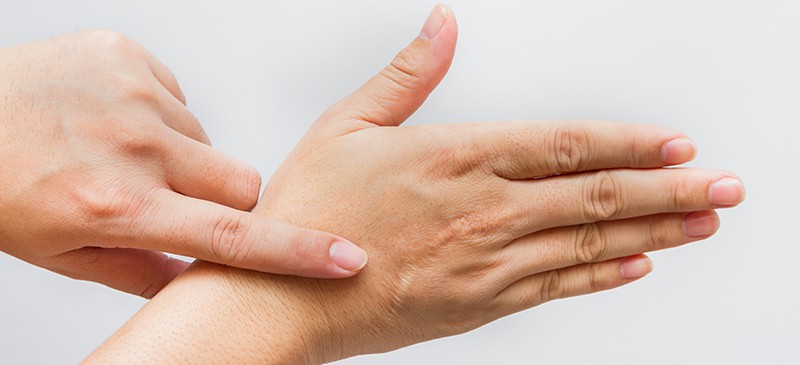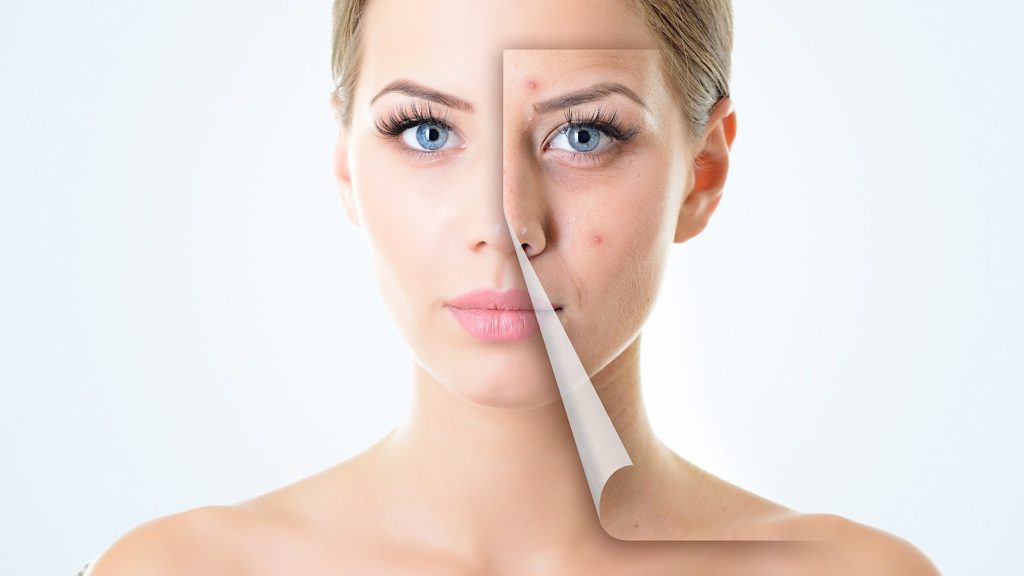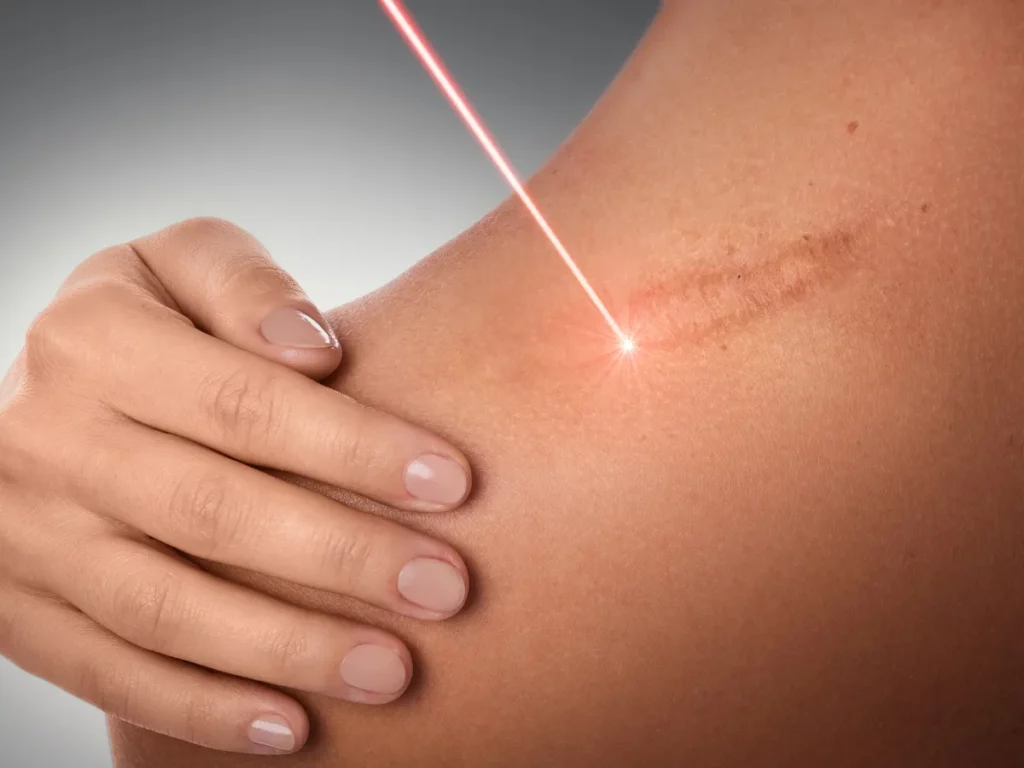A scar is a visible mark left on the skin after a wound or injury has healed. It occurs as a result of the body’s natural healing process, where a thick layer of collagen fibers forms to repair and replace damaged skin tissue. Scars can vary in appearance, size, and texture depending on factors such as the type and severity of the injury, the location of the body, and the individual’s skin type. While scars are a normal part of the healing process, some individuals may wish to minimize the appearance of scars due to their impact on self-esteem and confidence. There are various treatments available, both medical and natural, that can help reduce the appearance of scars and improve the overall texture and tone of the skin.
Types of Scars
Scars are a normal part of healing after an injury. Our body forms them as it repairs and replaces damaged skin with new collagen fibers. However, scars can differ in appearance and cause. Here are some common types of scars:
1. Keloid Scars: These scars are raised, thick, and extend beyond the boundaries of the original injury. They occur due to an overproduction of collagen during healing and can be itchy and painful.
2. Hypertrophic Scars: Similar to keloid scars, these scars are raised and red, but they remain within the boundaries of the original injury. They usually fade over time but can cause discomfort.
3. Contracture Scars: These scars occur when the skin tightens and restricts movement due to the loss of underlying tissue. Commonly seen after burns, contracture scars can affect muscles and nerves.
4. Acne Scars: Acne scars can vary in appearance, including depressed or raised areas on the skin. They are caused by inflammation during severe acne or when acne lesions are picked or squeezed.
Each type of scar may require different treatments. Some common options include laser therapy, chemical peels, cortisone injections, silicone sheets or gels, and surgical interventions. Scar treatments aim to minimize their appearance, improve texture, and promote healthy skin. Consulting with a dermatologist can help determine the most suitable treatment for your specific type of scar.
Medical Treatments
When it comes to effectively removing scars, medical treatments can offer reliable and proven solutions. These treatment options are especially beneficial for severe scars that may not respond well to natural remedies. Medical treatments for scar removal include various procedures and interventions that aim to improve the appearance and texture of scars, ultimately restoring confidence and enhancing overall skin health. From laser therapy and chemical peels to cortisone injections and skin grafts, these medical treatments are backed by scientific evidence and are carried out under the supervision of trained professionals. With the ability to target different types of scars, whether it be acne scars, burn scars, or hypertrophic scars, medical treatments provide individuals with effective solutions to help diminish the visibility of scars and promote a smoother and more uniform complexion.

Laser Treatment
Laser treatment is a popular and effective method for reducing the appearance of scars. This treatment works by targeting blood vessels in the scarred area and stimulating collagen production.
During a laser therapy session, a high-energy beam of light is directed onto the scarred skin. The heat from the laser helps to break down the scar tissue and promote the production of new skin cells.
It’s important to note that laser treatment cannot eliminate scars. However, it can make them flatter, reduce redness, and alleviate pain and itchiness associated with scarring.
The precise type of laser used will depend on the type and severity of the scar. For example, vascular lasers specifically target blood vessels, reducing redness in scars caused by acne or injury.
For optimal results, multiple laser treatments may be necessary. The exact number of sessions required will depend on the individual and the nature of their scars.
It is always recommended to consult with a medical professional or dermatologist to determine if laser therapy is suitable for you. They can provide personalized advice and recommendations based on your specific needs.
Chemical Peels
Chemical peels are a popular treatment option for addressing scars and improving the overall appearance of the skin. During a chemical peel, a solution containing various acids is applied to the skin, which helps dissolve the outermost layer of damaged skin cells.
One of the main benefits of chemical peels is that they increase cell turnover, revealing fresher, smoother skin underneath. By removing the top layer of scarred skin, chemical peels can help reduce the appearance of scars and promote a more even skin tone and texture.
It’s important to note that chemical peels may work better for individuals with lighter skin tones, as they can cause temporary pigmentation changes in those with darker skin. However, there are specific types of chemical peels, such as those containing glycolic acid and azelaic acid, that have been found effective in treating acne scars and reducing pigmentation issues.
After undergoing a chemical peel, it is crucial to protect the skin from sensitivity to light and UV rays. This can be achieved by using sunscreen with a high SPF daily. Sunscreen not only helps prevent further damage to the skin but also ensures that the results of the chemical peel are maintained for a longer period.
If you are considering a chemical peel to treat your scars, it is best to consult with a qualified dermatologist or medical professional. They can assess your skin condition and recommend the most suitable type and strength of chemical peel to achieve optimal results.
Steroid Injection
Steroid injections are a medical treatment commonly used to remove firm or raised scars, such as hypertrophic or keloid scars. These injections are an effective way to soften and flatten the scar tissue, resulting in a smoother and less noticeable scar.
During a steroid injection procedure, a corticosteroid solution is injected directly into the scar. This solution works by breaking up the collagen fibers and reducing the thickened scar tissue over several weeks. The corticosteroid helps to decrease inflammation, which can contribute to the formation of raised scars.
It’s important to note that steroid injections are typically recommended for scars that are firm or raised, rather than superficial or discolored scars. The exact number of injections required will depend on the severity and size of the scar, as well as individual factors.
While steroid injections can be an effective treatment option for firm or raised scars, it’s essential to consult with a healthcare professional or dermatologist to determine if this approach is suitable for your specific scar type. They can assess your condition and provide personalized advice on the best course of action for scar removal.
Silicone Sheets
Silicone sheets are a popular and effective tool used to reduce the appearance of scars. These sheets are made from medical-grade silicone and can be easily applied to the affected area.
One of the key benefits of using silicone sheets is their ability to soften the skin and flatten the scar. The silicone material creates a protective barrier over the scar, which helps to retain moisture and promote healing. This can help to reduce redness and inflammation, as well as improve the overall texture and tone of the scarred skin.
Using silicone sheets is also incredibly convenient. They can be easily trimmed to fit the shape and size of your scar, and are usually reusable for up to three months. Simply wash the sheet with mild soap and water, and it’s ready to be applied again. Some sheets even have adhesive backing, making them stay securely in place throughout the day.
Overall, silicone sheets are an effective and non-invasive option for scar removal. They work by softening the skin, flattening the scar, and improving its overall appearance. If you’re looking for a simple and convenient way to reduce the visibility of your scars, consider giving silicone sheets a try.
Natural Remedies
Natural remedies for scar removal offer a gentle and effective approach to improving the appearance of scars. These remedies harness the power of natural ingredients and utilize techniques that promote the body’s natural healing process. From the use of apple cider vinegar to onion extract, these remedies provide a holistic approach to achieving smoother and healthier skin while minimizing the visibility of scars. Read on to discover some of the most popular and science-backed natural remedies for scar removal.
Cool Water or Ice Cubes
Cool water and ice cubes can be a simple yet effective method for treating scars. The benefits of using cool water or ice cubes for scar treatment are numerous.
Firstly, cool water or ice cubes can help reduce inflammation. Applying cold water to the scar can help constrict blood vessels and reduce blood flow, thereby reducing swelling and inflammation. This can provide relief from discomfort and help in managing any pain associated with the scar.
Secondly, cool water or ice cubes can ease discomfort. The cold sensation of cool water or ice can numb the nerve endings around the scar, providing temporary relief from any itching or stinging sensations. This can be particularly beneficial for fresh scars or scars that are causing discomfort.
Additionally, applying cool water or ice cubes directly to the scar can help minimize redness and swelling. The cold temperature can help to temporarily shrink blood vessels, leading to a reduction in redness and helping the scar appear less noticeable.
To use cool water or ice cubes for scar treatment, simply gently cleanse the scarred area with cool water or wrap an ice cube in a soft cloth and apply it to the scar for a few minutes at a time. It’s important to avoid applying ice or extreme cold directly to the skin to prevent any damage.
Apple Cider Vinegar
Apple cider vinegar is a natural remedy that has gained popularity for its potential benefits in scar removal. Its acidic properties make it effective in reducing the appearance of scars.
The acidic nature of apple cider vinegar can help remove the top layer of skin, thus promoting the growth of new, healthy skin cells. This exfoliating effect can gradually diminish the visibility of scars over time.
To use apple cider vinegar for scar removal, it is crucial to dilute it before application. Mix equal parts of apple cider vinegar and water to create a solution. This will help prevent skin irritation, as undiluted vinegar may be too strong for some individuals.
For acne scars, you can enhance the efficacy of apple cider vinegar by mixing it with honey. Honey has moisturizing and healing properties that can complement the effects of apple cider vinegar. Mix one tablespoon of apple cider vinegar with one tablespoon of honey, and apply the mixture to the scarred area. Leave it on for about 10-15 minutes before rinsing it off with lukewarm water.
Although apple cider vinegar shows promise in scar removal, it is essential to remember that results may vary depending on the severity and type of scars. It is advisable to perform a patch test before applying it to larger areas of the skin and consult a healthcare professional if you have concerns or pre-existing skin conditions.
Onion Extract
Onion Extract has gained popularity as a natural remedy for scar reduction due to its numerous benefits for skin health. One of its key properties is its anti-inflammatory effect, which can help reduce swelling and redness associated with scars. This can contribute to a more even skin tone and a less noticeable scar appearance.
In addition to its anti-inflammatory properties, Onion Extract has been found to inhibit collagen production. Collagen is a protein that plays a crucial role in scar formation. By slowing down collagen production, Onion Extract can help minimize the appearance of scars and promote a more natural healing process.
Scientific evidence suggests that Onion Extract can effectively fade scars over time. Its therapeutic compounds, such as quercetin and sulfur compounds, have been shown to improve the texture and coloration of scarred skin.
To use Onion Extract for scar reduction, you can find topical creams or gels that contain this ingredient. Apply a small amount of the product to the scarred area and gently massage it into the skin. For best results, use it twice daily as part of your skincare routine.
While Onion Extract can be a helpful natural remedy, it’s important to note that results may vary depending on the individual and the type of scar. For severe or persistent scars, medical treatments such as laser therapy or cortisone injections may be more suitable options. As always, it is advisable to consult with a dermatologist before starting any new scar treatment regimen.
Healthy Skin Care Routine
Having a healthy skincare routine is crucial when it comes to scar removal. Not only can it help reduce the appearance of scars, but it also promotes overall skin health. By following a consistent skincare routine, you can enhance the healing process and boost collagen production, leading to smoother and healthier skin.
A daily skincare routine should include key steps such as cleansing, exfoliating, moisturizing, and protecting your skin from sun damage. Cleansing the skin removes dirt, oil, and impurities that can clog pores and hinder the healing process of scars. Exfoliating helps to remove dead skin cells and promote cell turnover, allowing new, healthy skin to surface.
Moisturizing is essential to keep the skin hydrated and nourished. It helps to improve the texture and appearance of scars by keeping the skin supple and preventing dryness. Additionally, protecting your skin from harmful UV rays is crucial in scar reduction. UV exposure can darken scars and slow down the healing process.
To enhance the healing process and collagen production, consider incorporating products with active ingredients like glycolic acid into your skincare routine. Glycolic acid helps to exfoliate the skin, promote cell regeneration, and improve collagen production, leading to a faster and more efficient healing process.
At-Home Treatments
When it comes to reducing the appearance of scars, several at-home treatments can be effective. These treatments can help to fade scars, improve skin texture, and promote the natural healing process. While it is important to note that severe scars may require professional medical treatments, these at-home remedies can often produce noticeable results when used consistently and correctly. From natural remedies to topical treatments, there are various options available for scar removal that can be easily incorporated into your daily skincare routine. It’s important to remember that results may vary depending on the type and severity of the scar, as well as individual skin types and conditions.

Laser Therapy
Laser therapy is a highly effective and popular method for removing scars. This non-invasive treatment utilizes laser technology to target blood vessels within the scar tissue, resulting in a reduction in the appearance of scars and various associated benefits.
By focusing on the blood vessels, laser therapy helps to make scars flatter and less red. This process not only improves the cosmetic appearance of the scar but also relieves pain and itchiness associated with scar tissue.
There are different types of laser treatments available for scar removal. Pulsed dye laser treatment is commonly used to address red scars, such as those caused by acne or surgery. This laser targets the blood vessels in the scar tissue, shrinking them and reducing redness.
On the other hand, laser resurfacing is effective in treating various types of scars, including those caused by acne, surgery, or injury. This treatment uses fractionated laser technology to stimulate collagen production and resurface the skin, resulting in improved texture and appearance.
With laser therapy, the specific type of laser treatment used will be determined by the type and severity of the scar, as well as the patient’s skin type and condition. Before undergoing the treatment, it is important to consult a qualified dermatologist or skincare professional to determine the most suitable laser treatment for your unique needs.
Overall, laser therapy is a highly beneficial and versatile option for scar removal. By targeting blood vessels within the scar tissue, laser therapy can result in flatter, less red, and more aesthetically pleasing scars. Consider consulting with a professional to explore the most suitable laser treatment for your specific scar removal needs.
Natural Healing Processes
During scar formation, the body undergoes various natural healing processes that contribute to the overall healing of scars. These processes occur in stages and are essential for the transformation of damaged tissue into scar tissue.
The first stage of scar healing is characterized by redness and raised texture. This initial phase, known as the inflammatory phase, is the body’s response to injury. Blood vessels at the site of the wound dilate, allowing immune cells and growth factors to reach the damaged tissue. Inflammation plays a crucial role in clearing away dead cells and debris, preparing the ground for new tissue formation.
As the inflammatory phase subsides, the scar enters the proliferative phase. During this stage, collagen production increases, aiding in the formation of new tissue. Fibroblasts, specialized cells, synthesize collagen and other components of the extracellular matrix. The scar becomes paler and more organized, gradually gaining strength.
The final stage of scar healing is the remodeling phase. Collagen fibers undergo realignment, resulting in a softer, more pliable scar. The scar also achieves its natural color as blood vessels recede and melanocytes, responsible for skin pigmentation, migrate to the scar site. This phase may last for several months to years, depending on the size and depth of the scar.
It is important to note that natural healing processes during scar formation vary from person to person, influenced by factors such as age, overall health, and the type of injury. By understanding these stages of scar healing, individuals can provide optimal care and support to aid in the recovery process.
Conclusion
In conclusion, scar healing is a complex process that involves the three stages of inflammation, proliferation, and remodeling. During this process, new tissue is formed and collagen production increases, resulting in a gradual improvement in the appearance of scars.

